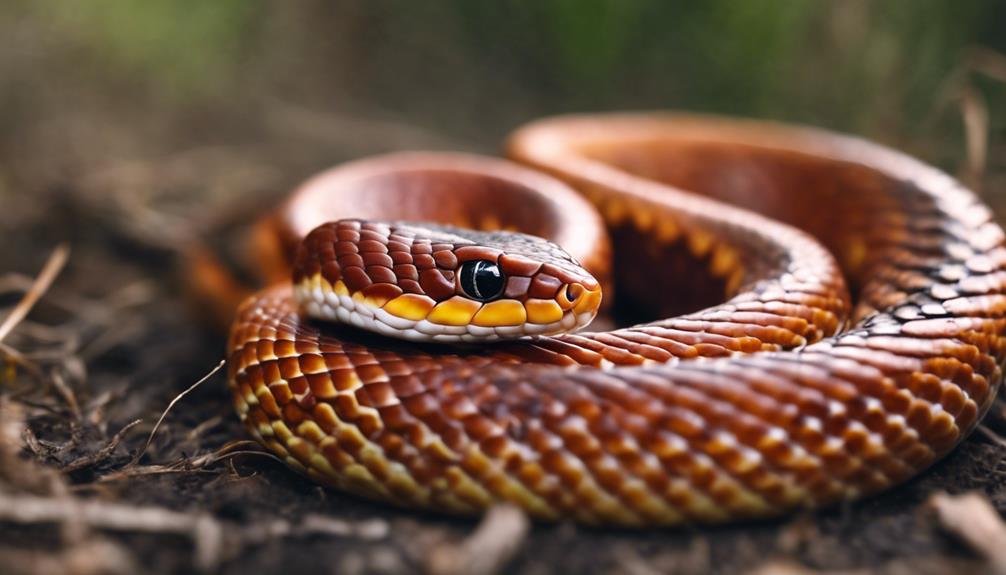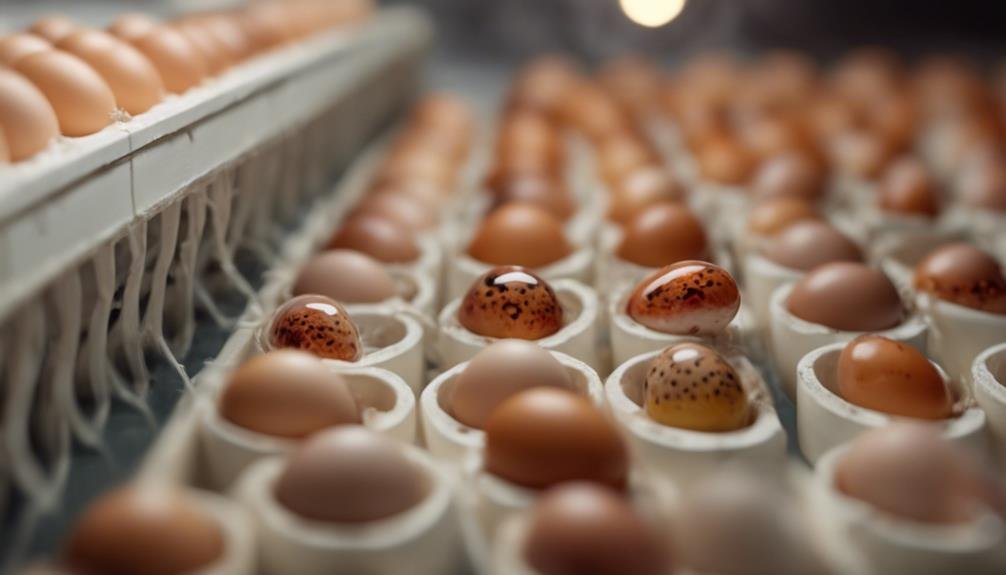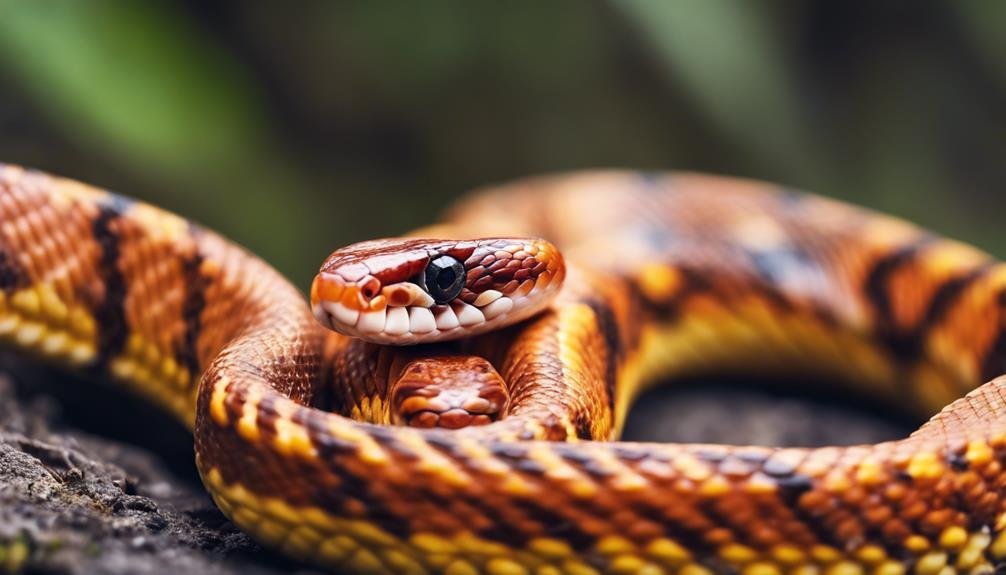If you've ever wondered how corn snakes mate, you're stepping into a fascinating aspect of reptile biology that's as intriguing as it is complex. These snakes engage in a dance of courtship and copulation that requires keen observation and understanding for successful breeding. The male snake shows interest through specific behaviors, but it's not always straightforward; complications such as disinterest from the female or environmental stress can hinder the process. As you explore further, you'll uncover the intricacies of initiating mating, the challenges that may arise, and the essential steps for post-mating care that can make all the difference in successful reproduction. What impact do these factors have on the breeding success of corn snakes? Let's explore.
Key Takeaways
- Corn snakes mate through copulation, with males showing courtship behaviors and using spurs to stimulate the female for successful sperm transfer.
- Mating can involve several hours of copulation, requiring a stress-free environment and careful monitoring of the female's health post-mating.
- Adjustments to temperature and lighting, alongside a brief fasting period, can cue breeding behaviors and prepare snakes for a successful mating season.
- Unsuccessful copulation may result from environmental factors or lack of female interest, necessitating a carefully managed and stress-free mating environment.
- Complications in breeding include aggressive behavior, developmental issues with embryos due to improper incubation, and the need for attentive care for multiple clutches.
Understanding Corn Snake Mating
To fully grasp how corn snakes mate, it's important to understand that they employ a process known as copulation, where the male inserts one of his hemipenes into the female's cloaca. When you're looking into breeding corn snakes, this fundamental knowledge sets the stage for everything that follows.
The male corn snake exhibits a fascinating courtship behavior, actively pursuing the female and engaging in rituals like rubbing against her and aligning their bodies in a precise manner. This isn't just about the physical act; it's a complex dance that guarantees both snakes are ready for mating.
Another intriguing aspect of corn snake mating is the male's combativeness. They may fight over a female, displaying their strength and size. It's nature's way of ensuring the strongest genes are passed on. However, this can also lead to complications. Aggression between the snakes, unsuccessful attempts at copulation, or even reproductive issues stemming from health or stress can occur. It's a delicate balance, and successful breeding corn snakes requires an understanding of these behaviors and potential hurdles.
Preparing for Breeding Season
As you gear up for the breeding season, paying close attention to the temperature and lighting in your corn snakes' environment is vital.
You'll also need to adjust their diet to make sure they're in peak condition for mating.
Adjusting Temperature and Light
Preparing your corn snakes for breeding season involves gradually adjusting the temperature and lighting in their environment. You'll need to decrease the temperature to 11-14°C, mimicking winter conditions, and then slowly increase it back to 28-29°C. This temperature fluctuation signals to your snakes that it's time to breed. During this period, stop feeding them for 3 weeks to simulate natural conditions more closely.
Weather changes, especially rainy conditions, can also cue breeding behaviors in corn snakes. To support these natural instincts, make sure their environment has ideal temperature and lighting. This creates a comfortable, stress-free setting that encourages mating. Don't forget to include a nest box in their enclosure, providing a secure place for the female to lay her eggs post-mating.
Diet Before Mating
Why should you focus on your corn snakes' diet before mating season?
Preparing your snakes for the breeding season means ensuring they're well-fed and in prime health to successfully breed. A balanced diet, rich in essential nutrients, is vital for meeting the energy demands of mating.
It's important to maintain a healthy weight; both overweight and underweight snakes may encounter difficulties during the mating process. Adequate nutrition not only supports the development of viable eggs but also leads to the birth of healthy offspring.
Enclosure Cleaning Essentials
After ensuring your corn snakes have a balanced diet before mating season, the next step is to focus on cleaning their enclosure. Thoroughly clean the enclosure to eliminate any waste or debris left from last year that might harbor bacteria or parasites. Use a reptile-safe disinfectant to sanitize all surfaces, including hides and water dishes.
It's important to replace the substrate with fresh, clean bedding to maintain a hygienic environment conducive to breeding. Check and replace any damaged or soiled decor items to prevent potential health issues.
Initiating the Mating Process
In the complex dance of courtship, a male corn snake initiates mating by closely following and gently rubbing against the female, signaling his interest and readiness to mate. This behavior, an integral part of the mating process, isn't just about physical proximity but also about demonstrating his suitability as a mate to the female. The male uses his spurs to lightly stimulate the female, a move that can be pivotal in convincing her to engage in mating.
As the courtship progresses, the male may resort to more specific behaviors like chin rubbing and body twitching. These actions serve to entice the female further, making her more receptive to his advances. It's a delicate balance of persistence and subtlety, aimed at aligning their bodies in preparation for copulation. This alignment is crucial for the successful transfer of sperm and ultimately, for fertilization to occur.
Understanding this intricate courtship ritual is key to appreciating the complexities involved in the reproduction of corn snakes. It's a nuanced process, where every action by the male is designed to win over the female, ensuring that the cycle of life continues.
Copulation and Post-Mating Care


Once the intricate dance of courtship concludes, corn snakes engage in copulation, a vital phase where the male inserts one of his hemipenes into the female's cloaca to guarantee successful fertilization. This process isn't a quick affair; it can last several hours, often involving the male shaking his tail vigorously to stimulate the female and make sure the mating is successful.
After this pivotal moment, your role in post-mating care becomes essential. Providing a quiet, stress-free environment for the female is crucial to foster successful fertilization. This means minimal disturbances and maintaining ideal conditions in her enclosure. You'll notice the female's appetite might increase significantly as her body prepares for egg development and laying. This is a natural progression, signaling the need for additional nutrients to support the forthcoming clutch.
Monitoring the female for signs of successful copulation and ensuring her health remains stable in the weeks following mating is critical. Any changes in behavior or appetite should be noted, as these can be early indicators of her pregnancy status or potential health concerns. Remember, the success of breeding corn snakes hinges not only on the act of mating itself but equally on the vigilant post-mating care you provide.
Recognizing Complications
While most corn snake matings proceed without problem, it's important to recognize and address any complications that may arise. Among these, unsuccessful copulation is a common issue. Sometimes, female corn snakes may not be receptive to the male's advances, leading to unsuccessful mating attempts. This lack of interest can stem from various factors, including environmental conditions not being ideal for mating. Ensuring the temperature and humidity are right is essential for encouraging successful interactions.
Aggressive behavior is another complication to be wary of. It's not unusual for mating attempts to turn aggressive, risking injuries to either snake. If you notice any signs of aggression, such as biting or overly forceful behavior, it's crucial to separate the snakes immediately and monitor them for any injuries.
Observing your snakes closely during the mating process is key to minimizing potential complications. Intervention might be necessary to make sure both snakes remain healthy and that the mating process goes smoothly. Remember, creating a comfortable and stress-free environment for your corn snakes can greatly reduce the risk of complications and promote successful mating.
Egg Incubation and Hatchling Care


After guaranteeing successful mating and addressing any complications, it's time to focus on the next step: egg incubation and hatchling care for your corn snakes. Once your female corn snake lays her eggs, you'll need to remove them immediately to prevent any potential damage. These eggs are delicate, so handle them with the utmost care.
You should incubate corn snake eggs at a steady temperature range of 27-29°C to guarantee successful hatching. This specific temperature range is critical and maintaining it will help you avoid any developmental issues with the embryos. The typical incubation period lasts about 60-75 days, so patience is key. During this time, keep a close eye on the temperature and humidity levels within the incubator to ensure they remain consistent.
Be prepared for the possibility that your female corn snake may lay multiple clutches of eggs within a single breeding season, a phenomenon known as double clutching. This can be both exciting and demanding, as it requires additional care and attention to guarantee the health and well-being of both the mother and her hatchlings. By carefully managing the incubation process and providing attentive care to the hatchlings, you'll help guarantee a successful outcome for your breeding efforts.
Is It Possible to Successfully Breed Corn Snakes Without Using Brumation?
Yes, it is possible to successfully breed corn snakes without using brumation. There are alternative methods that can be used to stimulate breeding in corn snakes. This breeding corn snakes article will explore different techniques that can be employed to achieve successful breeding without the use of brumation.
Conclusion
In summary, successfully breeding corn snakes involves understanding their mating behaviors and creating a supportive environment.
You'll need to prepare for breeding season, facilitate the mating process, and guarantee proper post-mating care. Recognize potential complications early to address them swiftly.
Following copulation, careful egg incubation and hatchling care are essential.
By staying attentive and informed, you can navigate the complexities of corn snake reproduction and contribute to the healthy propagation of these fascinating creatures.


